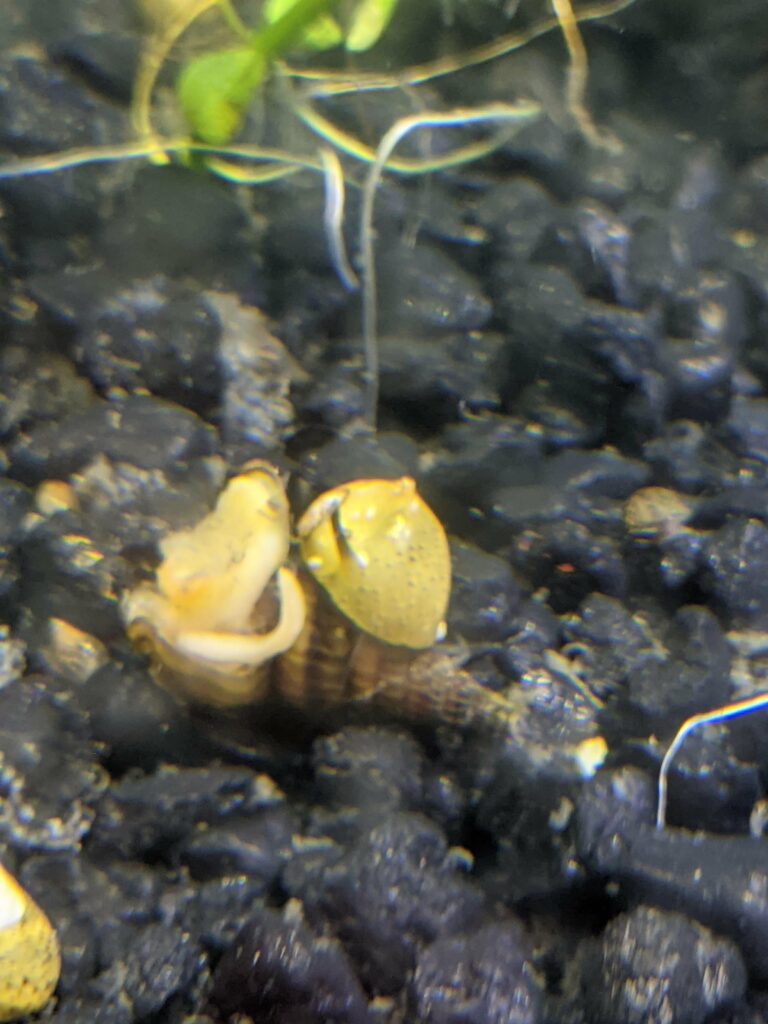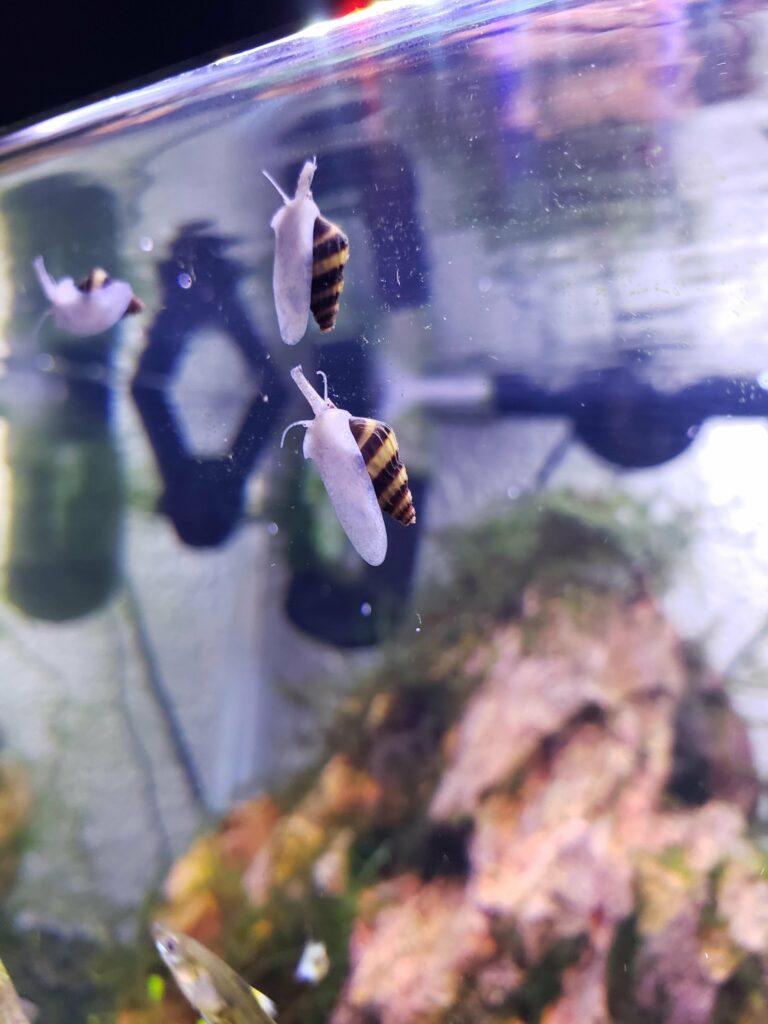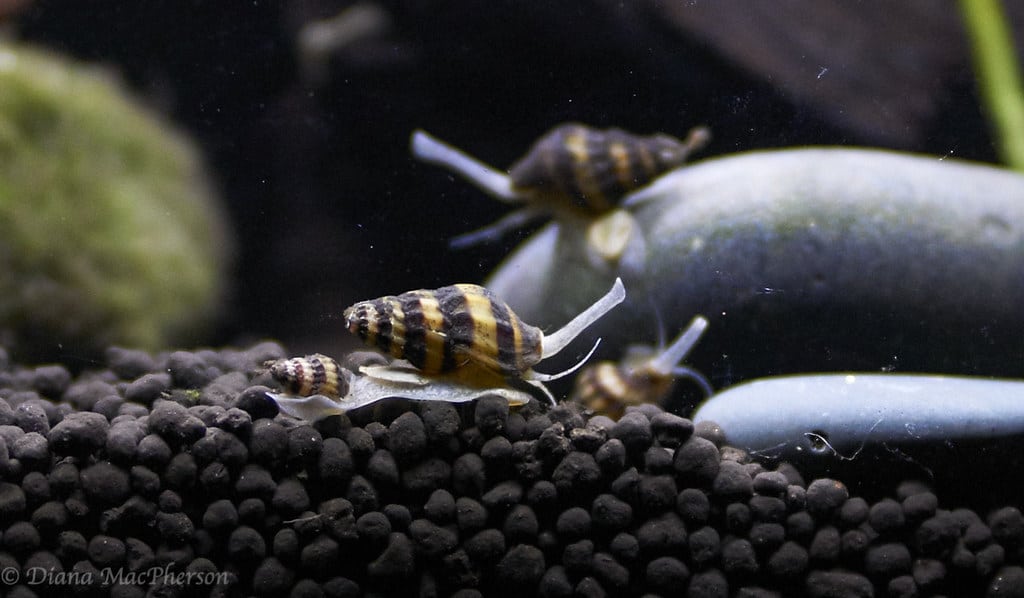Assassin snail care is very different from just about any other freshwater snail out there. If you’ve ever kept ramshorn, Malaysian trumpet snails, or mystery snails then you’re probably aware of their tendency to reproduce and overpopulate aquariums.
The assassin snail is very different from these species. Not only do they lay few eggs but they don’t eat algae or rotting plants.
Instead, these are carnivores with a special taste for their mollusk cousins. This makes them great for freshwater snail control, though they are interesting in their own right as aquarium inhabitants.

Let’s take a look at what the assassin snail has to offer and see if you can forgo using aquarium snail killer for unwanted pest snails in your tank.
What Are Assassin Snails?
The assassin snail is from Southeast Asia. They are most common in Thailand and Malaysia, down into Indonesia. As members of the family Nassariidae, the majority of their relatives are found in the ocean. However, the assassin snail is found solely in freshwater environments

A fully mature assassin snail can reach 2 inches in length. But the majority will barely top 1 inch, including the whorled shell, making them a fairly small species of snail.
While not particularly difficult to breed they aren’t as prolific as other snails and don’t come in the dizzying array of color morphs that ramshorns and nerite snails do. Their simple striped pattern is why they are also known as the bumblebee snail.
And they are one of the more active species. When not resting under fine substrates assassin snails wander around rocks, glass, and plants hunting for the scent of prey.
They get their name from the fact that they preferentially feed on other snails. While they have an easier time managing similar-sized snails like ramshorns they will gladly bite even larger snails like rabbit and apple snails.
Assassin snails have a mouth and rasping radula that they can extend into the shells of other snails. The radula acts as a scouring pad, slowly grating away flesh and blood and weakening their prey. Other assassin snails pick up on the scent of an attack and work together to bring down even larger snails. Once finished, all that is left are empty snail shells cleaned of flesh.
Best of all, you won’t see snail population explosions when keeping an assassin snail. In fact, they are very useful at reducing nuisance snail explosions, which we will discuss in greater detail below.
- Scientific Name: Clea helena
- Origin: Southeast Asia & Indonesia
- Size: Up to 2 inches
- Temperament: Peaceful; Predatory
- Difficulty: Easy
- Price: $3-5
Assassin Snail Care Issues
Despite being specialized carnivores assassin snails are easy to care for so long as you make allowances for their diets, water quality needs, and substrate preferences.
Tank Size for Assassin Snails
Since new assassin snails are small and not especially active aquarium residents you can keep them in smaller tanks easily.
You may need to add small groups of assassin snails to the tank if you have a larger aquarium that is heavily infested with pest snails. But tank size is irrelevant so long as you have enough hired assassins to take out the pests.
Assassin Snail Water Conditions
Healthy and stable parameters are very important for many reasons. And invertebrates of all kinds are especially sensitive to ammonia, nitrite, and nitrate. While fish can tolerate higher levels you want nitrates as close to 0 ppm as possible when keeping assassin snails.
Be careful with plant fertilizers if keeping them in a planted tank. Many fertilizers use nitrate as a nitrogen source, which is bad for snail safety if dosed too heavily.
Since they are carnivores that eat at snail-like speeds leftover meaty debris will tend to rot. This will cause frequent spikes in toxic nitrogen compounds like ammonia if water quality is allowed to get problematic.
Water temperature-wise, they prefer things on the warmer side of things. As a Southeast Asian species, they should be kept from 70-82F. Moderate levels of water hardness are also important because snail shells are built from dissolved minerals.
Plants And Substrate
Assassin snails are carnivorous and thus safe when kept with live plants. However, they also will not eat algae and prey on snails that do. If you need algae eaters stick with Dwarf Otocinclus and Freshwater Shrimp.
Substrate-wise they should be kept in aquariums with fine sand or soil because they burrow. This burrowing assists in improving the free flow of oxygen and nutrients to the roots of live plants. Fine substrates tunneled through by assassin snails also have less chance of compacting over dead organic matter and forming anoxic pockets of toxic gas.
When newly born young assassin snails will spend most of their time burrowed, only leaving when food is scented. Adults spend more time above the substrate but also submerge themselves constantly with only their siphons exposed.
Feeding Assassin Snails
Feeding assassin snails is the only part of their care that can be problematic. As carnivores, they aren’t satisfied with scraps of algae and detritus.
They will accept commercial fish flakes and pellets, which are usually high in fish meal and other protein-rich supplements. However, they should not be forced to rely on removing excess uneaten food. It’s better to feed them at night or in an invertebrate tank full of slow feeders.
Assassin Snails prefer meaty items like frozen brine shrimp and bloodworm cubes and fresh slices of fish or beef heart. In the tight confines of an aquarium, the smell of fresh meat will hit their two tentacles in seconds.
This encourages them to unburrow and make a direct line towards the source of the scent. Soon the food will be covered with assassin snails busily eating. If one of your fish or shrimp dies during the night you may awaken to find a dead fish covered in snails.
Sometimes people take this as a sign that the snails killed the fish but they aren’t capable of doing so. Shrimp fry may be in danger but when it comes to adults they are shrimp safe.
Tank Mates for Assassin Snails

Since they are carnivorous but otherwise peaceful, assassin snails can work in any sort of aquarium setup. They are best kept with a small number of peaceful, similarly-sized fish and invertebrates who won’t consume all of the food before the snails have a chance to get their share of it.
Great Tank Mates for Assassin Snails:
- Small community fish (tetras, danios, etc)
- Killifish
- Dwarf Cichlids
- Freshwater Shrimp
- Surface Dwelling Fish
- Corydoras
- Dwarf Otocinclus
Algae control can be difficult since you can’t keep them with other snails. Any algae-eating fish or shrimp can work however Plecostomus are best avoided as they can suck snails right out of their shells when fully grown.
Cichlids, Pufferfish, large Catfish, and Cyprinids are also poor tank mates because they will simply swallow them whole or crush them with powerful throat muscles and teeth.
Tank Mates to Avoid Keeping with Assassin Snails:
- Pufferfish
- Medium to Large Cichlids
- Cyprinids (Goldfish, Large Barbs, etc)
- Crayfish
- Plecostomus
- Medium to Large Catfish
- Other Snails
Using Assassin Snails to Control Pest Snails
One of the most common reasons to buy an assassin snail is because you have a pest snail problem. The following edible snails are known to cause problems in the aquarium hobby when their populations explode:
- Malaysian Trumpet Snails
- Ramshorn Snails
- Apple/Mystery Snails
- Bladder Snails
- Pond Snails
Getting snail numbers under control can be a real hassle. While chemical methods do work, if there are too many snails you can cause even greater problems by killing them suddenly. Bodies trapped in the tank will rot en masse, causing water parameters to become toxic to fish and even snails.
While an assassin snail will try to tackle larger snails they do prefer eating trumpet snails and other small snail species.
Depending on the size of the outbreak and aquarium, you’ll likely want to purchase multiple assassin snails. They can’t reproduce asexually and only lay a single egg at a time so they won’t simply multiply in the same manner as herbivorous snails.
Two snails per 10 gallons is a good start for freshwater tanks infested with ramshorn or trumpet snails.
As they come across snail slime trails assassin snails quickly follow them back to their source and climb onto the shells of other snails to keep them from escaping.
In the confines of an aquarium they can eventually exterminate other snails – if you buy fewer assassin snails than mentioned above then they will do an admirable job of controlling pest snails without eliminating them.
Assuming they do kill off their food source you’ll then need to either rehouse your assassin snails or start offering meaty foods to keep them from starving.
Another bonus to keeping an assassin snail is that they are known for eating snail eggs. Except for mystery and apple snails, which lay their eggs above water.
Snail eggs can be nearly invisible and very difficult to find and remove. But they will only eat the soft kind. Hard nerite snail eggs, for instance, are too tough to be edible.
Breeding Assassin Snails
Assassin snails are not as prolific as other snails. But when given the right water parameters they will likely breed in just a few weeks’ time for you.
Conditioning Assassin Snails
The best way to get assassin snails to breed is to provide mates, warm temperatures, 0ppm nitrates, fine substrates for adults and young to feel comfortable in, and high-quality food. If there are no live snails for them to hunt then provide fresh and frozen meat.
Assassin snails are not hermaphrodites and reproduce sexually. While they do have defined male and female sexes the differences are impossible for aquarists to detect. Since only the Snails can tell you’ll want to buy enough of them to ensure you get a good selection of potential matches.
Young Assassin Snail Care
Once well-fed, offered mates, and mature, they will eventually breed on their own. Assassin Once well-fed, offered mates, and mature, they will eventually breed on their own. Assassin snails mate and lay a single egg roughly once per month.
Each yellow boat-shaped assassin snail egg sack eventually turns a deeper shade of brown and develops over the course of a month when kept in temperatures around 80F. Cooler water can slow the development process to as long as two months.
The baby assassin snails burrow into the sand if possible almost instantly and remain hidden save when food presents itself. They will also begin hunting and consuming other snails well before they are fully mature.
Over the course of six months, your baby assassin snails eventually reach their full adult size and sexual maturity. Like adults, they feed on live snails, protein-rich prepared foods, and dead fresh or frozen meat.
In Conclusion
The assassin snail is a great addition to most aquariums. A hungry assassin snail feeds mostly on other snails, helping keep their numbers in check. They also eat dead fish, fish flakes, and any other sources of protein before it can decay into ammonia.
They do spend a lot of time hiding. But when they are out in the open, the speed and activity of an assassin snail make them interesting aquarium residents in their own right.
Frequently Asked Questions about Assassin Snails
Still hoping to learn more? Then here are a few more tips on caring for an assassin snail.
Unlike nearly every other freshwater snail out there Assassin Snails are pure carnivores. They won’t eat algae, dead plants, or other leftovers. Instead, they need fresh protein in the form of fresh fish, blood worms, brine shrimp, and even other snails. They will also eat protein-rich flake food and pellets, which are mostly made of fish meal.
Assassin Snails stay very small, growing no larger than 2 inches in size and are usually smaller than that!
Assassin Snails are not usually sold in chain pet stores like Petsmart or Petco. You have a better chance of finding them in locally owned specialty aquarium stores. If your local fish store does not have Assassin Snails then you should try this list of online fish and plant retailers instead!
It really depends on who you ask. Some aquarists report that they have found Assassin Snails eating their shrimp. But it’s unclear whether the shrimp was already weakened and about to die or if the snail actively hunted and killed it.
Since Assassin Snails don’t have any way of securing their prey other than latching onto it and eating it alive I think any shrimp killings happen when the shrimp is already about to die. Even baby shrimp are much too fast to be caught by a snail. And of course, these carnivorous snails will gladly hunt down and eat any freshly dead shrimp they smell on the currents in your tank.


How many blood worms should I feed 1 assassin snail and how often? He’s just about 1/4 inch.